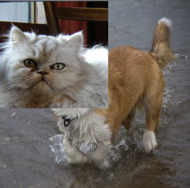✂️ CutMix#
[How to Use] - [Suggested Hyperparameters] - [Technical Details] - [Attribution] - [API Reference]
Computer Vision
CutMix is a data augmentation technique that modifies images by cutting out a small patch and replacing it with a different image. It is a regularization technique that can improve the generalization accuracy of computer vision models.
|
|---|
An image with CutMix applied. A picture of a cat has been placed over the top left corner of a picture of a dog. This image is taken from Figure 1 from Yun et al. (2019). |
How to Use#
Functional Interface#
Here we run CutMix using index labels and interpolating the loss (a trick when using cross entropy).
# Run the CutMix algorithm directly on the batch data using the Composer functional API
import torch
import torch.nn.functional as F
import composer.functional as cf
def training_loop(model, train_loader):
opt = torch.optim.Adam(model.parameters())
loss_fn = F.cross_entropy
model.train()
for epoch in range(num_epochs):
for X, y in train_loader:
X_cutmix, y_perm, area, _ = cf.cutmix_batch(X, y, alpha=0.2)
y_hat = model(X_cutmix)
loss = area * loss_fn(y_hat, y) + (1 - area) * loss_fn(y_hat, y_perm)
loss.backward()
opt.step()
opt.zero_grad()
Composer Trainer#
# Instantiate the algorithm and pass it into the Trainer
# The trainer will automatically run it at the appropriate points in the training loop
from composer.algorithms import CutMix
from composer.trainer import Trainer
cutmix = CutMix(alpha=1.0)
trainer = Trainer(
model=model,
train_dataloader=train_dataloader,
eval_dataloader=eval_dataloader,
max_duration='1ep',
algorithms=[cutmix]
)
trainer.fit()
Implementation Details#
CutMix is implemented following the original paper. This means CutMix runs immediately before the training example is provided to the model and on the GPU, if one is being used.
The construction of the bounding box for the mixed region follows the paper’s implementation which selects the center pixel of the bounding box uniformly at random from all locations in the image and clips the bounding box to fit. This implies that the size of the region mixed by CutMix is not always square, and the area is not directly drawn from a beta distribution. It also implies that not all regions are equally likely to lie inside the bounding box.
Suggested Hyperparameters#
Setting alpha=1 is a standard choice. This produces a uniform distribution, meaning the interpolation between the labels of the two sets of examples is selected uniformly between 0 and 1.
Technical Details#
CutMix works by creating a new mini-batch of inputs to the network by operating on a batch (X1, y1) of (inputs, targets) together with version (X2, y2) with the same examples but where the ordering of examples has been shuffled.
The final set of inputs X is created by choosing a rectangular box within each example x1 in X1 and filling it with the data from the same region from the corresponding example x2 in X2.
The final set of targets y is created by sampling a value interpolation (between 0.0 and 1.0) from the Beta distribution parameterized by alpha and interpolating between the targets y1 and y2.
❗ CutMix Produces a Full Distribution, Not a Target Index
Many classification tasks represent the target value using the index of the target value rather than the full, one-hot encoding of the label value. Since CutMix interpolates between two target values for each example, it must represent the final targets as a dense distribution. Our implementation of CutMix turns each label into a dense distribution (if it has not already been converted into a distribution). The loss function used for the model must be able to accept this dense distribution as the target.
CutMix is intended to improve generalization performance, and we empirically found this to be the case in our image classification settings. The original paper also reports improvements in object localization and robustness.
🚧 Composing Regularization Methods
As general rule, composing regularization methods may lead to diminishing returns in quality improvements. CutMix is one such regularization method.
Data augmentation techniques can sometimes put additional load on the CPU, potentially to the point where the CPU becomes a bottleneck for training. To prevent this from happening, our implementation of CutMix (1) takes place on the GPU and (2) uses the same patch and interpolation for all examples in the minibatch. Doing so avoids putting additional work on the CPU (since augmentation occurs on the GPU) and minimizes the additional work on the GPU (since all images are handled uniformly within a batch).
🚧 CutMix Requires a Small Amount of Additional GPU Compute and Memory
CutMix requires a small amount of additional GPU compute and memory to produce the mixed-up batch. In our experiments, we have found these additional resource requirements to be negligible.
Attribution#
CutMix: Regularization Strategy to Train Strong Classifiers with Localizable Features by Sangdoo Yun, Dongyoon Han, Seong Joon Oh, Sanghyuk Chun, Junsuk Choe, and Youngjoon Yoo. Published in ICCV 2019.
This Composer implementation of this method and the accompanying documentation were produced by Cory Stephenson at MosaicML.
API Reference#
Algorithm class: composer.algorithms.CutMix
Functional: composer.functional.cutmix_batch()
